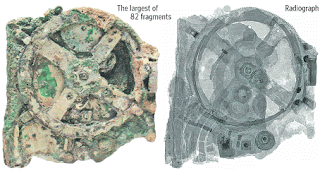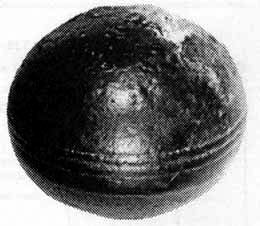The antikythera mechanism is currently housed in the Greek National Archaeological Museum in Athens and is thought to be one of the most complicated antiques in existence. At the beginning of the 20th century, divers off the island of Antikythera came across this clocklike mechanism, which is thought to be at least 2,000 years old, in the wreckage of a cargo ship. The device was very thin and made of bronze. It was mounted in a wooden frame and had more than 2,000 characters inscribed all over it. Though nearly 95 percent of these have been deciphered by experts, there as not been a publication of the full text of the inscription.
Mystery is everywhere around us...it is everything what we cannot explain... But why we must stay in the dark? Start with me the journey in the world of mystery...who knows what we can find out...
Friday 10 August 2012
The Antikythera Mechanism
The antikythera mechanism is currently housed in the Greek National Archaeological Museum in Athens and is thought to be one of the most complicated antiques in existence. At the beginning of the 20th century, divers off the island of Antikythera came across this clocklike mechanism, which is thought to be at least 2,000 years old, in the wreckage of a cargo ship. The device was very thin and made of bronze. It was mounted in a wooden frame and had more than 2,000 characters inscribed all over it. Though nearly 95 percent of these have been deciphered by experts, there as not been a publication of the full text of the inscription.
Dropa Stones
The Dropa stones, otherwise known as the Dzopa stones, Dropas stones or Drop-ka stones, are said by some ufologists and pseudoarchaeologists to be a series of at least 716 circular stone discs, dating back 12,000 years, on which tiny hieroglyph-like markings may be found.Each disc is claimed to measure up to 1 foot (30 cm) in diameter and carry two grooves, originating from a hole in their center, in the form of a double spiral. The hieroglyph-like markings are said to be found in these grooves.
For twenty years the Dropa stones were said to have sat in storage before they were given to Tsum Um Nui for study in 1958. It is said the he came to the conclusion that the grooves on the discs were actually very tiny hieroglyphs, none of which were of a pattern that had been seen before, and which can only be seen with the use of a magnifying glass. By 1962, he had allegedly deciphered them into a story that told of a spacecraft that crashed landed in the area of the cave, the Bayan Har Shan region and that the ship contained the Dropa people who could not fix it and therefore had to adapt to Earth. Further, his research claims that the Dropa people were hunted down and killed by the local Ham tribesmen for a period. Tsum Um Nui noted specifically that one glyph apparently said "The Dropa came down from the clouds in their aircraft. Our men, women and children hid in the caves ten times before sunrise. When at last they understood the sign language of the Dropas, they realized that the newcomers had peaceful intentions"
Russian researchers requested the discs for studying, and allegedly several were shipped to Moscow. Once there, it is said that they were scraped for loose particles and put through a chemical analysis which revealed that they contained large amounts of cobalt and other metallic substances. As recorded in the Soviet magazine Sputnik, Dr. Vyatcheslav Saizev describes an expriment where the discs were supposedly placed on a special turntable whereby they were shown to 'vibrate' or 'hum' in an unusual rhythm as though an electric charge is passing through them.
The Grooved Spheres
Over the last few decades, miners in South Africa have been digging up mysterious metal spheres. Origin unknown, these spheres measure approximately an inch or so in diameter, and some are etched with three parallel grooves running around the equator. Two types of spheres have been found: one is composed of a solid bluish metal with flecks of white; the other is hollowed out and filled with a spongy white substance. The kicker is that the rock in which they where found is Precambrian – and dated to 2.8 billion years old! Who made them and for what purpose is unknown.
Subscribe to:
Posts (Atom)






